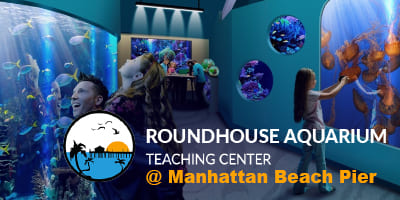OPEN DAILY- Manhattan Beach Pier
The Roundhouse Aquarium is located at the end of the Manhattan Beach Pier. The Roundhouse has undergone a recent revitalization through a $4 million capital project spearheaded by the Harrison Greenberg Foundation. The new Roundhouse Aquarium educates and inspires more than 300,000 visitors every year. It is managed and operated by the nonprofit oceanic and environmental organization Oceanographic Teaching Stations, Inc. (OTS), whose mission is to connect and engage visitors and students to the oceans through hands-on interactive experiences with marine life and habitats of southern California, and to inspire them to become good stewards of our environment.
OTS’ programs at the Roundhouse Aquarium promote the study of the oceans, tidelands and beaches of Southern California through a wide slate of science-based and standards-aligned education programs with its immersive and engaging exhibits of a diverse array of marine life. More than 100 marine animals from Southern California’s waters live at the aquarium, many are native to its local waters in the Santa Monica Bay. Notable wildlife include moon jellies, sharks, octopus, sheepshead, moray eels, lobsters, and more – as well as a touch tank with sea stars, sea cucumbers, sea urchins and sea snails. The aquarium prides itself on being family oriented. It’s a great place for kids to take their parents!
Come SEA our Marine Exhibits
Get to know the habitats within Southern California by visiting our diverse marine exhibits. These exhibits are showcased within 4 Aquarium Galleries.
Marine Habitat Gallery
The Rocky Reef shows us what reefs in the cold California waters look like. They are similar to coral reefs but are made up of rocks instead of corals. They are just as important of a habitat as coral reefs and often serve as a nursery for many types of juvenile fish.
The Kelp Forest tank represents a distinct southern California marine habitat. This tank shows us what it looks like to swim at the edge of the kelp forest, where rocks become scarcer and sand more plentiful. Many of the animals in the tank can live their life deep within the kelp forest or at the very edge. Those animals at the edges can even camouflage in the sand.
Education Gallery
Deep Kelp Forest Tank
These tanks represent a very diverse and abundant habitat, the kelp forest! The giant kelp that grows 2 feet a day, provides food and shelter for many different animals. Not only is this habitat important for animals, but it is also important to humans as well! Seaweeds, like kelp, produce about 70% of our oxygen through photosynthesis. So, take a deep breath and thank kelp!
Tide Pool Tank
All the animals that you can find in our touch tank live in a habitat called a tide pool. When the tide is low and the water has receded, pools of water are left in between rocks which form the tide pools. In Southern California, we have 2 high tides and 2 low tides every day, which means the animals’ habitat is always changing. They must have special adaptations that allow them to live in such a dynamic habitat.
Pier Piling Tank
Have you ever wondered what is under the pier? This tank will give you a good idea! Pier pilings, while man made, do create a habitat for lots of animals ranging from mussels, to crabs, to fish and rays. The fish can either hide amongst the mussels or lay on the sand under the pier among the rays.

Marine Science Gallery
Jewel Tank
See our animals in the spotlight with cool adaptive traits like our spotted rose anemone that has biofluorescence and our baby swell shark eggs that can camouflage as seaweed. The baby swell sharks are really cute when they hatch out too!
Pipefish Tank
The Pipefish tank is an example of a mudflat with eelgrass beds that act as a nursery for young fish and young sting rays. See if you can spot a pipefish in the eelgrass.
Artificial Reef Tank
The Artificial Reef tank is an examples of man-made structures left behind that now act as reefs teaming with life from sea anemones on rock scallops to sea stars to juvenile rockfish. Can you see the bright orange Garibaldi with blue spots?
Octopus Tank
The octopus tank is an example of a deep water habitat brought to life for our guests to see. It features anemones and rock scallops on the reef which also add structure and microhabitats to the reef. The decorator crab uses the colonial strawberry anemones to help decorate its body to camouflage with the reef. There are small but colorful rockfish like the half-banded rockfish that stay close to the rocks and use them as shelter.
Kid’s Kelp Corner
Have you ever wondered oh why, oh why did my goldfish die? Come find the answer in the Kid’s Kelp Corner. You can also relax and read the many ocean related books in our library while watching our inquisitive freshwater fish.
Discovery Center
Come check out what it means to be a scientist! Observe plankton, learn about the food chain, and discover some of the aquarium’s smallest residents.
Seahorse Tank
Seahorses are some of the most fragile sea creatures in the ocean, and they can camouflage to look like seaweed, eelgrass, or even sea fans. They use their tails to hold onto eelgrass and stay upright, but they won’t swim except in short bursts. They have excellent eyesight that they use to track their prey, which are small shrimps.
Immersion Gallery












